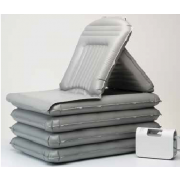Electric sit-to-stand, stand-up patient lifts and Stand Assist Lifts. Manual and battery-operated Sit to Stand Lifts are able to lift a patient from sitting to semi-standing position. Patients can then be transferred in an upright position to a wheelchair or commode. Sit-to-Stand Lifts are commonly used with a Transport Sling or a Standing Sling which wraps around the patient's back thus providing support during the tranfer. Most manufacturers recommend that the patient have at least 60% weight bearing capacity in addition to good upper body control, as they will need to use their ams to stabilize themselves during the transfer.
-

HoyerPro Journey Portable Stand-Up Electric Lift - 340 lbs.
Model: HOY-JOURNEY-S Manufacturer: Hoyer INCLUDES FREE SLING!$3,663.00
INCLUDES FREE SLING!$3,663.00
What is a Sit-to-Stand Lift?
Sit-to-stand lifts are designed to help patients who lack the strength or muscle control to rise to a standing position from a bed, wheelchair, chair, or commode. They use straps, vests, or belts (as opposed to slings) positioned around the patient's back usually fitting under their arms. They are therefore technically not "sling lifts" which are used for vertical patient transfer. Sit-to-stand lifts fix the patient legs in position exerting pressure on the patient's caves as the belt or strap is tightened by the lift mechanism. This tightening gradually moves the patient's body diagonally into a standing position. Standing is medically beneficial to reduce conditions such as osteoporosis which can occur when a disabled patient's bones weaken over time because they are no longer used support the patient's weight.
Sit-to-stand devices are designed to transfer a patient between two seating surfaces. These include surfaces such as a commode, shower or transfer bench, wheelchair, chair, and bedside or mattress. The physical demands required to transfer a patient using a sit-to-stand device are significantly less than manually performing a stand-and-pivot transfer thus decreasing the chances of caregiver back or shoulder overexertion injuries. Since sit-to-stand lifts typically have a smaller base than floor sling lifts, they can more easily fit and maneuver a patient into tight spaces such as bath and shower rooms.
The limitations of sit-to-stand lifts is that patients must be able to first sit up and second to physically support their own weight while in a standing position in order to use these devices.










